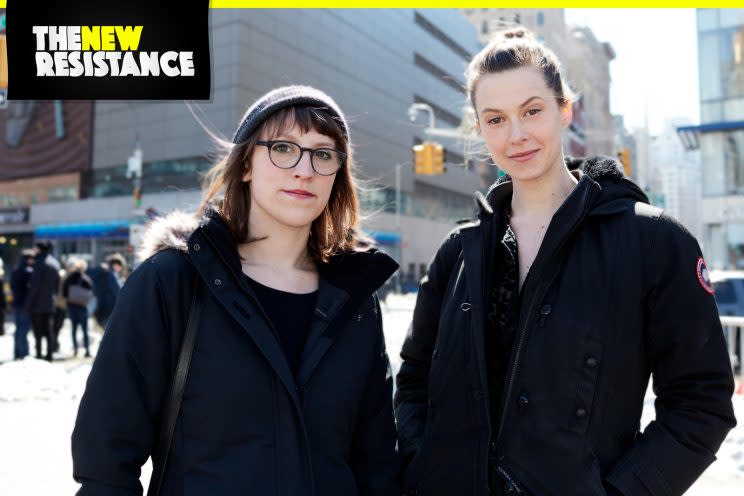Elettra Wiedemann Wants You to Switch Bank Accounts

By day, Magenna Brink, who grew up in North Carolina and went to the Savannah College of Art and Design, is a textile designer for Earthbound. But in recent months, she’s taken to weaving together hearts and minds in Brooklyn, where she lives, around progressive causes. And she’s been joined in her effort by borough-mate Elettra Wiedemann, a model turned food blogger and the daughter of actress Isabella Rossellini.
It all started last year when Brink got caught up in the presidential campaign of Bernie Sanders. “His ideals and values of getting big corporate money out of politics aligned perfectly with mine,” says Brink, who identifies as a Democratic Socialist. “I didn’t feel like I had much power until his campaign came along.”
When it did, she started Grassroots Action NY to raise money for the campaign and to register Brooklyn voters. In her neighborhood, she was one of the so-called Bushwick Berners.
Then, of course, Hillary Clinton beat Sanders in the primaries — and Trump beat Clinton in the general election. “Everyone I worked with on the Sanders campaign was pretty down about that,” she says. But she wanted to keep her anti-corporate activism alive — so late last year she trained it on the months-long protests at North Dakota’s Standing Rock reservation against the part of the Dakota Access Pipeline (DAPL), funded by large banks, that was set to run through Native American land and potentially ruin the water supply there.
She hooked up Grassroots Action NY to the broader Defund DAPL movement, which works to persuade individuals and governments to divest in protest from several big banks (such as Citibank, TD Securities, and Wells Fargo) that fund the pipeline — and to do business instead with local credit unions or eco-conscious banks like Amalgamated, which last year became the first bank to divest completely from fossil fuels.
“A lot of Bernie supporters are Standing Rock supporters,” she says. “In the election, we felt like we watched big business and corporate money end up running the show — and here we were again, watching them do that against the indigenous people of North Dakota. It felt important for us to do what we could for the protesters.” So Brink started a working group within Grassroots Action NY to help the Defund DAPL movement.
And in stepped Wiedemann, who previously had dabbled in activism, organizing fashion events to raise money for solar energy for a hospital in the African nation of Burundi. During the Obama years, she says, “I was like, ‘Oh, somebody else is taking care of this, so I can sit back.'”
But with so many issues at stake now in the Trump/GOP Congress era, “this is the first time in my life I’m going to activist meetings and doing conference calls,” says Wiedemann, who lives in Brooklyn’s Fort Greene area. “As someone who’s worried about climate change, I’m very scared by this administration and how they want to completely erase America’s involvement in the Paris Agreement on climate change, which took almost 20 years to create. I can’t just sit back and not get involved.”
So she, Brink, and others came up with the idea of a coolly designed, one-page, ’90s-style “zine” that anyone can download, print, copy, and distribute. The zine breaks into baby steps the process of switching from a DAPL-funding bank, such as: 1) finding a new, non-DAPL bank and setting up an account, 2) delinking all of one’s direct deposits and auto-billpays from the old account and relinking to the new one, and finally, 3) closing the old account with a statement of protest.
And that’s where the fun — and the group activism component — came in. On March 18, about 50 folks in Brink and Wiedemann’s #DivestmentDay movement met at Manhattan’s Union Square, where the special speaker was Rick Chavolla of the nearby American Indian Community House. Then the group broke into cadres to go to nearby branches of various corporate banks that fund the DAPL — including TD, Chase, Citibank, Bank of America, and Wells Fargo — to close their accounts in a mass protest.
Together, they divested more than $250,000.
“We took pictures and videos for Instagram and Facebook stories, and hashtagged everything with #DivestmentDay,” says Wiedemann, who has already switched from TD and HSBC to Amalgamated — a process she says took two weeks. That outing was merely the first, with the next set for May 13. “We’ll email you reminders about the daily steps you take until the day you go to the bank to close your account,” says Brink.
Plus, she notes, “We’re using this as a stepping stone to pressure New York City to follow suit with cities like Seattle,” which in February divested $3 billion from Wells Fargo to protest DAPL funding.
Currently, it looks as if the DAPL, which Trump supports, is going forward rapidly, but Brink stresses that big banks fund a wide variety of fossil-fuel ventures, as well as other industries, such as private prisons, “that hurt a lot of people. We need to tell banks that we, as Americans, don’t stand for it, especially today when we don’t have a lot of power in our federal government. We have to at least speak with our money.”
Brink admits that there’s not much in common between textile design and activism. “My job is kind of predictable, whereas there are all kinds of weird turns in activism,” she says.
Yet there is one skill that’s transferable, she notes: empathy. “It’s easy to be in a hurry and bark orders, but you really have to be patient and hear where people are coming from.”
All the more so with activism, she notes. “People are working for free!”
Read more on Yahoo Style + Beauty:
Follow us on Instagram, Facebook, and Pinterest for nonstop inspiration delivered fresh to your feed, every day. For Twitter updates, follow @YahooStyle and@YahooBeauty.


